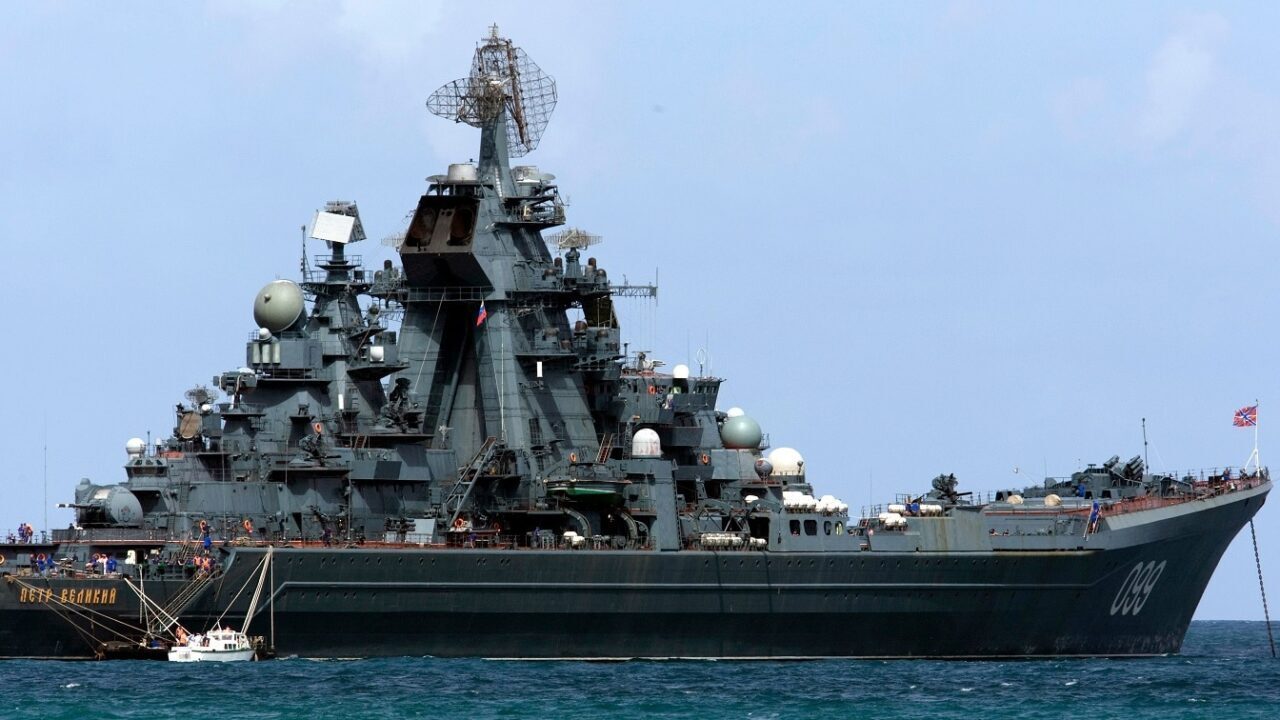The Russian Navy could soon be forced to make a hard decision – namely what vessel could be made its “flagship.” Currently, the Kirov-class battlecruiser Pyotr Velikiy (Peter the Great), the largest surface combatant nuclear-powered vessel in the world that isn’t an aircraft carrier, fills that role – but the warship could be withdrawn from service as early as next year.
At issue is the cost of any potential modernization for the vessel, and given that her sister ship Admiral Nakhimov has been undergoing a decades-long repair and refit – not to mention the odyssey of the modernization of Moscow’s sole aircraft carrier Admiral Kuznetsov – it could be easy to see why the Kremlin may opt to retire its flagship battlecruiser.
There has been no official announcement made, but Admiral Nakhimov is expected to be handed over to the Russian Navy in 2024. At that time it is likely the current flagship could be retired from service.
“Currently, the issue of withdrawing Peter the Great from the Navy is being worked out. It seems that the experience of repairing and modernizing the Admiral Nakhimov of the same type has shown that this is very costly,” a source in the Russian Navy told the state-media outlet Tass last week.
The fact that the rumors have begun circulating at this time is somewhat notable as it was twenty-five years ago, on April 18, 1998, that the St. Andrew’s flag, Russia’s naval ensign, was hoisted for the first time on the nuclear-powered vessel.
Key Facts for Pyotr Velikiy
The heavy nuclear-powered missile cruiser Pyotr Velikiy is officially classified as part of the Project 1144.2 family of vessels (codename: Orlan; NATO reporting name: Kirov), a series of four Soviet and Russian multipurpose surface combat ships equipped with nuclear power plants and guided missile weapons for blue-water oceangoing operations.
The keel-laying ceremony for the heavy nuclear-powered missile cruiser (Serial Number 803) took place on April 25, 1986. Initially named Kuibyshev, it was later renamed The Yuri Andropov (in honor of the General Secretary of the Central Committee of the Communist Party of the Soviet Union). The warship was launched on April 25, 1989 – and following the dissolution of the Soviet Union, in 1992 the ship was rechristened as Pyotr Velikiy in honor of Tsar Peter I (Peter the Great), founder of the Russian Imperial Navy.
The battlecruiser has a displacement of 24,300 tons (standard) and 28,000 tons (full load). It measures 252 meters (827 feet) in length and 28.5 meters (94 feet) in the beam. Though developed in the Cold War, the warship still carries an impressive array of weapons, including 20 P-700 Granit (SS-N-19 Shipwreck) anti-ship missiles, 64 3K95 Kinzhal surface-to-air missiles, 48 S-300FM Fort-M surface-to-air missiles, and six Kashtan (CADS-N-1) point defense gun/missile systems.
There was also speculation from Tass last week that when the battlecruiser is retired, its name would be given a nuclear-powered submarine.
“After The Pyotr Veliky cruiser has been withdrawn from the Navy, the strategic nuclear submarine of the Borey-A project will inherit this name,” the Russian Naval source added.
Current plans call for a total of six Borey subs to be built for the Northern and Pacific Fleets. With the completion of this series, the Navy will have 14 new strategic submarines, including 11 Borey-A class subs and three Borey class ones.
The Incredible Shrinking Russian Navy
Even as efforts are being made to build new submarines, the Russian Navy has struggled to return its sole aircraft carrier to service. It has also been forced to retire its oldest vessels.
In February, the Kremlin decommissioned the nuclear-powered strategic submarine Dmitry Donskoy, which had been the largest nuclear sub in the world. Previous state media reports had suggested the boat would remain in service until at least 2026. The Russian Navy’s Project 941 Akula-class (NATO reporting name Typhoon) heavy nuclear ballistic submarine was laid down in June 1976 and commissioned in 1984.
After almost 40 years in service, she was finally retired. She could now be joined with Russia’s largest surface combatant.
MORE: Video – Ukraine Has Massive New NATO ‘Cannon’ Ready To Fight Russia
MORE: ‘Americans Will Pay The Price’: One Democrat Is Angry At Joe Biden
MORE: Could Joe Biden Get Impeached?
Author Experience and Expertise:
A Senior Editor for 19FortyFive, Peter Suciu is a Michigan-based writer. He has contributed to more than four dozen magazines, newspapers, and websites with over 3,200 published pieces over a twenty-year career in journalism. He regularly writes about military hardware, firearms history, cybersecurity, politics, and international affairs. Peter is also a Contributing Writer for Forbes and Clearance Jobs. You can follow him on Twitter: @PeterSuciu.

